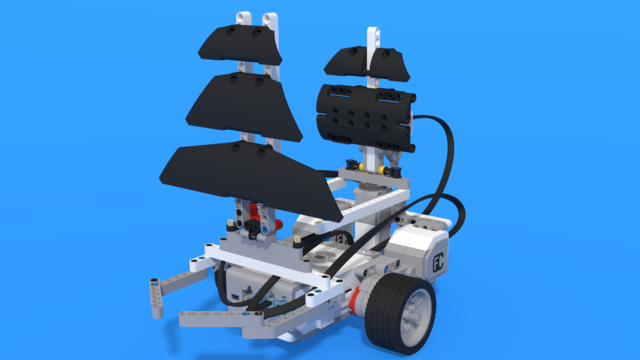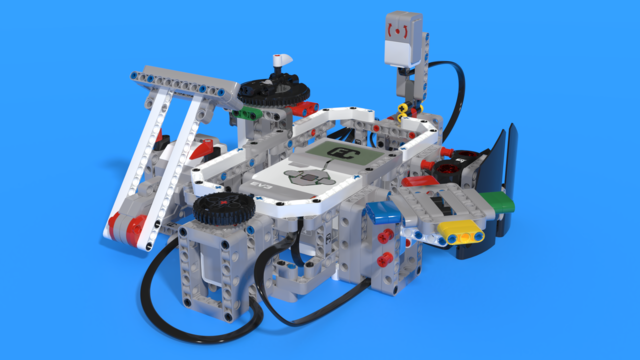We are already familiar with the Gyro sensor and we know how to use it with the Wait Block and wait for a comparison to return true. But what is the other setting ('change') of the block doing?

To access the full video please subscribe to FLLCasts.com
- #1258
- 08 May 2019

Similar to the option to compare, the option for change has two modes:
- Angle - the robot waits for the Gyro sensor to detect a change in the angle, by default 10 degrees. This change could be in both directions - the angle could increase by 10 degrees or decrease by 10 degrees. Of course, you can configure the block to wait specifically for increase or decrease.
-
Rate - the robot waits for the Gyro sensor to detect a change in the speed in which it is turning, by default 10 degrees per second. This change could be in both directions - the angle could increase by 10 degrees or could decrease. Of course the sensor could be configured to wait only for one of them.

These blocks are very useful to detect diversions from the right path. If someone hits the robot, the rate of turn will change a lot! Of course, you can find other solutions!
Courses and lessons with this Tutorial
This Tutorial is used in the following courses and lessons

Level D2. "Seafaring". Robotics with LEGO
The eighth level of the Robotics with LEGO curriculum for students in third or fourth grade.
In this level, students learn to use the fourth sensor in the robotics set - the gyro sensor. The robots are modeled after boats, yachts, and ships. With the help of the gyro sensor, students can set a course for their robots to a given angle and can detect deviations from the course. In open seas, there may be sea-monsters and the robots are being programmed to detect a sudden change in acceleration with the help of the said sensor.
- 24
- 2:49
- 107

Lesson 4 - Yacht
Introduction
Let's imagine we are billionaires. Every self respected billionaire must have a yacht ![]() . A robot yacht is exactly what we would now build.
. A robot yacht is exactly what we would now build. 
The modern yachts are custom build for a luxury life. They could have a bathroom, bedroom with a nice view, living room, kitchen and even a room for play.
What would you like to have on the board of your yacht? Why?
All of this of course has a price. If we are slightly less rich billionaires we would take a yacht starting at about $200,000. And the price could go up indefinitely. There is a rumor that the most expensive yacht is for over $4,000,000,000 dollars. It was made with more than 100,000 tons of gold and platinum - two of the most expensive materials on earth. There are walls made from real tyrannosaur rex bones and diamonds each costing 45 million dollars. Luckily, we are also billionaires and we could afford all of this. We would leave up to you to decide if you need a wall full of tyrannosaur Rex bones.
- 4
- 5
- 8
- 3d_rotation 1

Robotics with LEGO - Level 4.0 - Kinesthetic and Memory Game (in development)
The seventh level of the Robotics with LEGO curriculum for students in sixth or seventh grade.
In this level, student develop a memory training game. The player must remember series of actions like press a button, shake a pole, pull a lever, show one of many colors. In order to program the game, students use many variables and modify their states. Students create their own custom sounds and images, in order to reflect their own personality in the game. In the end of the level, the game stores top scores even after a full shut down with the help of text files.
- 59
- 2:58
- 200

Remind yourself how to work with the gyro sensor
You've seen the gyro sensor. It has two arrow. How does it work? What does it do?
- 6
- 0
- 0
- 3d_rotation 0

Robotics with LEGO - Level 2.5 - Maritime Journey
The fourth level of the Robotics with LEGO curriculum for students from fifth to twelfth grades.
In this level students focus on the rotational sensor that is part of every motor in the robotics set. Students also learn to use the fourth sensor in the robotics set - the gyro sensor.
First few robot constructions imitate sea-animals and their behavior. Students create programs that check whether the robot's claws or pecks have successfully caught an object. That sensor in the motors allows the robots to go back in their lairs even after the use of unlimited movement. The rest of the robots are modeled after boats, yachts, and ships. With the help of the gyro sensor, students can set a course for their robots to a given angle and can detect deviations from the course. In open seas, there may be sea-monsters and the robots are being programmed to detect a sudden change in acceleration with the help of the said sensor.
- 42
- 3:52
- 133

Additional tasks for the yacht robot
Taking so many decisions makes our robot be really inefficient.
- 2
- 2
- 2
- 3d_rotation 0